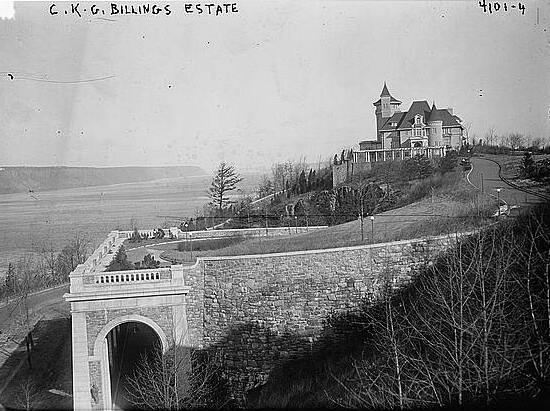Last-Minute NYC Holiday Gift Guide 🎁
We’ve created a holiday gift guide with presents for the intrepid New Yorker that should arrive just in time—



The 154-foot-long gallery at Fort Tryon Hall is visible to drivers on the Henry Hudson Parkway.
If you’ve ever driven along the Henry Hudson Parkway, you may have wondered about the vine-covered granite arches on the steep slope of Fort Tryon Park near the Cloisters at the northern tip of Manhattan. What appears to be the remnants of an old Roman aqueduct was actually part of an elaborate private driveway constructed for Cornelius King Garrison Billings (1861-1937) during the Gilded Age in New York City — with a little help from a cow.
There’s been much written about the C.K.G. Billings estate and the $250,000 driveway that led to his new mansion perched 250 feet above the Hudson River (check out Untapped C.K.G. Billings’ Mansion in Fort Tryon Park). But you may be surprised to learn that it was a milk cow that “designed” the 1,600-foot switchback roadway.
In 1907, C.K.G. Billings, the multi-millionaire equestrian renowned for his C.K.G. Billings “Horseback Dinner” of 1903, moved into the lavish Fort Tryon Hall overlooking Fort Washington Avenue and Riverside Drive. He shared the huge Louis XIV château with his wife Blanche E. MacLeish Billings, two children, and 23 servants. The estate was considered among the most lavish private houses in Manhattan, and featured several large towers, a bathhouse with a 75-foot marble heated swimming pool, squash courts, a “fumed oak” bowling alley, and a yacht landing on the Hudson River at Dyckman Street.

This view of C.K.G. Billings’ mansion shows the elaborate S-curve driveway leading over the arched gallery and up to the hillside estate. Image via Library of Congress
One of Billings’ favorite pastimes was driving his four-in-hand along the newly paved Riverside Drive. On a whim, he decided that it would be wonderful to be able to access his estate and horse stables by carriage via Riverside Drive rather than from Fort Washington Avenue. The only problem with this idea was that the driveway would have to be at low grade to accommodate horses and carriages while ascending 100 feet within a section of property that was just 200 feet wide but 500 feet long.
While some reports claim that General Nogi Maresuke of the Imperial Japanese Army was asked to design the driveway, a short article titled “A Novel Pathfinder” buried on page 18 of The New York Times September 8, 1912 Billings – which was just six days before General Nogi committed suicide – suggests a more novel idea. According to the article, it was Billings’ neighbor, William C. Muschenheim, proprietor of the Hotel Astor, who solved the great driveway dilemma.
“You aren’t in any great hurry, so why don’t you have it done right? Put one of your cows on that land and give her time to lay out a path up that hill,” Muschenheim told Billings. “Trust her to find the easiest and most comfortable grade.”
Sure enough, over time, the cow traced out the easiest and best way up to her barn at the top of the hill. The result: A 1,600-foot double-switch-back drive built to follow her tracks.
Billings hired the architects Buchman & Fox to construct the extravagant driveway to his estate. They laid out the roadway and proposed a great arched stone gallery to accommodate a portion of the roadway that would leave the face of the earthen ridge. By using granite removed from the cliff to construct this 50-foot-high gallery, or bridge, the architects were able to create a driveway with a 6 percent grade.
Today, the arches are the only remains of the Billings estate, which deteriorated from a fire.
Check out the Remains of Fort Tryon Park’s Turn of the Century Mansion to see some great up-close photos of what it looks like today and see vintage photos of the Gilded Age estate in its original glory. Get in touch with the author @HatchingCatNYC
Subscribe to our newsletter